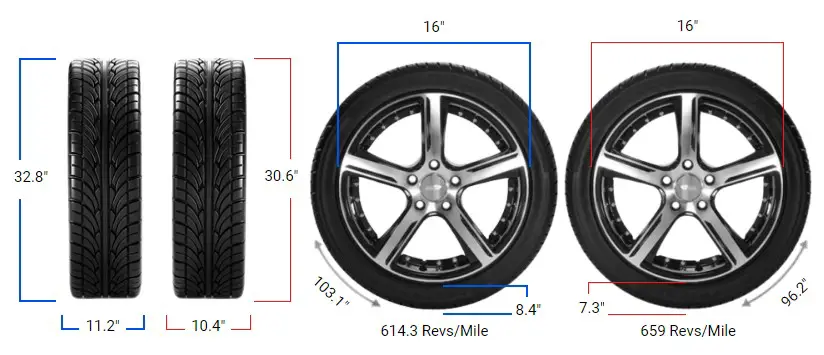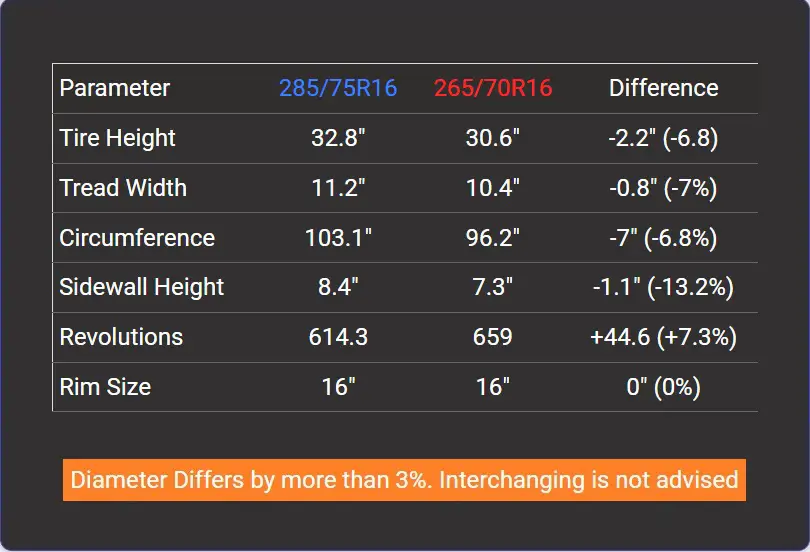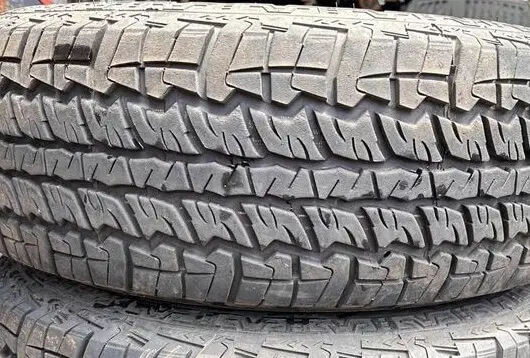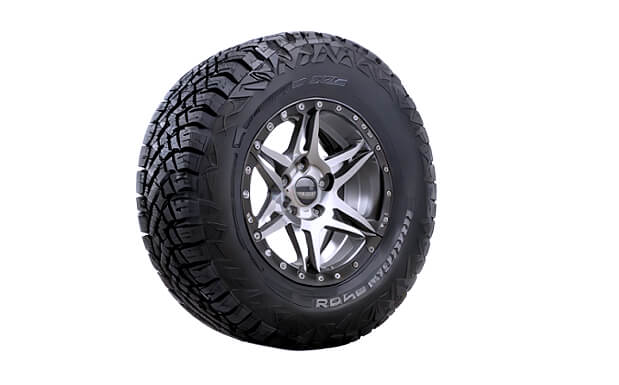Tire Size 285/75r16 vs 265/70r16

Switching from 285/75r16 to 265/70r16 tires involves a significant change in size and performance. This switch results in a smaller overall diameter, narrower width, and reduced sidewall height. Let’s explore the impacts of this tire switch on both on-road and off-road driving.
- Diameter decreases by 2.22 inches lowering ground clearance
- Width reduces by 0.79 inches potentially improving handling
- Sidewall height drops by 1.11 inches leading to a firmer ride
- Speedometer will read 7.3% higher than actual speed
- Tire revolutions per mile increase by 44.65 affecting fuel economy
285/75r16 vs 265/70r16 Table
The primary difference between 285/75r16 and 265/70r16 tires lies in their overall diameter.

Fitment Guide
The diameter difference between these tire sizes (-6.8%) exceeds the acceptable 3% range. Therefore, this interchange is not recommended without proper modifications.
Switching to the smaller 265/70r16 tire may require adaptations to prevent issues such as rubbing or clearance problems.
On-Road Impact
The switch to 265/70r16 tires will have several noticeable effects on your vehicle’s on-road performance. Let’s examine these impacts in detail:
- Gas Mileage: The smaller diameter of the 265/70r16 tire means the engine will need to work harder to maintain the same speed, potentially decreasing fuel efficiency. However, the narrower width may slightly offset this by reducing rolling resistance.
- Speedometer Accuracy: With the smaller tire, your vehicle will actually be traveling slower than what the speedometer indicates. At a displayed speed of 20 mph, your actual speed will be about 18.64 mph. This 7.3% difference can be significant, especially at higher speeds.
- Ride Comfort: The reduced sidewall height (-13.2%) of the 265/70r16 tire may result in a firmer ride. With less rubber to absorb road imperfections, you might feel more bumps and vibrations in the cabin.
- Acceleration: The smaller tire diameter will likely improve acceleration slightly, as the engine doesn’t need to turn as much mass to get the vehicle moving.
- Handling: The narrower width of the 265/70r16 tire (-0.79 inches or 20 mm) may improve steering response and cornering stability on paved roads.
- Aesthetics: The switch to smaller tires will lower your vehicle’s stance slightly, which some may find visually appealing. However, it might create a less imposing look compared to the larger 285/75r16 tires.

Off-Road Impact
Changing to 265/70r16 tires will also affect your vehicle’s off-road capabilities. Here’s how this switch might influence your off-road adventures:
- Ground Clearance: The 2.22-inch (56.5 mm) reduction in overall diameter will lower your vehicle’s ground clearance. This decrease can be significant when navigating obstacles or rough terrain, potentially increasing the risk of underbody damage.
- Traction: The narrower width of the 265/70r16 tire might provide better performance in mud or snow by cutting through these surfaces more easily. However, it may offer less traction on rocky or loose surfaces compared to the wider 285/75r16.
- Flotation: The smaller contact patch of the 265/70r16 tire may lead to reduced flotation in soft surfaces like sand or deep mud, potentially increasing the likelihood of getting stuck.
- Rock Crawling: The decreased sidewall height might make the tire more susceptible to damage from sharp rocks or other obstacles. However, the smaller size could provide better maneuverability in tight spaces.
- Durability: The smaller 265/70r16 tire may be more prone to damage from off-road hazards due to its reduced size and sidewall height. This could potentially lead to more frequent tire replacements if you frequently engage in challenging off-road activities.

What is the Difference Between 285/75r16 and 265/70r16?
The main difference between 285/75r16 and 265/70r16 tires is the overall diameter. The 285/75r16 tire has a diameter of 32.83 inches, while the 265/70r16 tire has a diameter of 30.61 inches.
This represents a significant reduction of 2.22 inches or 6.8% in diameter when switching from the larger to the smaller tire. This change in diameter affects various aspects of vehicle performance, including ground clearance, speedometer accuracy, and overall driving characteristics.
Can I Use 265/70r16 Instead of 285/75r16?
No, it is not recommended to use 265/70r16 tires instead of 285/75r16 without proper modifications. The difference in diameter between these two tire sizes is 6.8%, which exceeds the typically recommended maximum difference of 3%.
This substantial change could negatively impact vehicle handling, speedometer accuracy, fuel efficiency, and overall performance. It may also cause issues with fitment and clearance.
How Much Taller Is a 285/75r16 Tire Than a 265/70r16?
A 285/75r16 tire is 2.22 inches (56.5 mm) taller than a 265/70r16 tire. The 285/75r16 has a diameter of 32.83 inches (833.9 mm), while the 265/70r16 has a diameter of 30.61 inches (777.4 mm).
This difference in height represents a 6.8% increase in overall diameter for the larger tire.
How Much Wider is a 285/75r16 Tire Than a 265/70r16?
A 285/75r16 tire is 0.79 inches (20 mm) wider than a 265/70r16 tire. The 285/75r16 has a width of 11.22 inches (285 mm), while the 265/70r16 has a width of 10.43 inches (265 mm). This difference in width represents a 7% increase for the larger tire.
Our Observation
Switching from 285/75r16 to 265/70r16 tires offers a mix of benefits and drawbacks. On-road, you may experience improved handling and slightly better acceleration, but at the cost of reduced ride comfort and inaccurate speedometer readings.
Off-road, the smaller tires provide better maneuverability in tight spaces but sacrifice ground clearance and overall capability in challenging terrain.
The difference in size is significant enough to noticeably impact both on-road and off-road performance. While some effects may be negligible for casual drivers, enthusiasts and frequent off-roaders should carefully consider these changes before making the switch. Ultimately, the decision depends on your driving habits and priorities.

Meet Caitlin McCormack, a Tire Size Expert and Blogger Passionate About Everything Related to Tires. With Years of Experience in the Tire Industry, Caitlin Has Become an Expert in Tire Sizes and Their Impact on Vehicle Performance.
